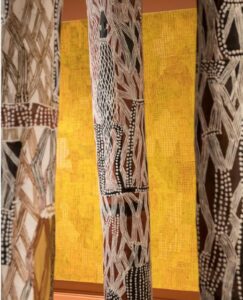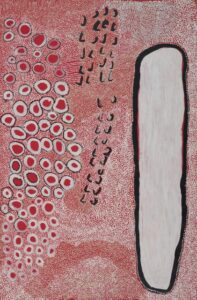Contemporary Women Artists from Aboriginal Australia

The Phillips Collection: Marking the Infinite, spotlights nine leading Aboriginal Australian women artists: Nonggirrnga Marawili, Wintjiya Napaltjarri, Yukultji Napangati, Angelina Pwerle, Lena Yarinkura, Gulumbu Yunupingu, Nyapanyapa Yunupingu, Carlene West, and Regina Pilawuk Wilson. The artists are from remote Aboriginal communities across Australia, and the subjects of their art are broad, yet each work is an attempt to grapple with fundamental questions of existence, asking us to slow down and pay attention to the natural world…
And so says the Phillips Gallery of Art in their introduction to this show of Australian Aboriginal women artists, currently displayed until September 9.
My colleague and I wandered into the gallery, rather heartened by the simplicity and quiet power on the walls. Parts of the show were quite arresting in the refined sense of form and pattern. It “felt” organic. This “feeling” did not last long, it faded before our very eyes as we became more aware critically of what we were seeing and how it was put together. What we began to suspect was rather deflating our hopes. And sure enough, we realized we were looking at self conscious made for gallery “art”. We may have been hoodwinked for a few minutes insofar as we were gazing upon “discovered” aboriginal culture. These mighty discovers/curators of art brought forth into civilization of the vaguely primitive or first people anthology of culture, a tribal culture of the indigenous native people of Australia…BUT No, that was not the case. And I have to admit it saddened me as much as any cultural disruption of indigenous people in the world today by the encroaching “world”.
“Appropriation” is a big word in the art world, it refers to the ongoing of art “taking” from other art, whether from time, culture, history or style, so as to recomprise or “borrow” it completely in order to recontextualize a given work of art. This is a standard of art history either thematically, specifically, or outright replication of imagery. This is nothing new … think Greek, Roman, Renaissance, Neo Classical or Post Mod seizure of pictures in art history or pop culture or attitude etc. This is the case here in a different respect. These ladies were “asked” to view their heritage so as to aesthetically update it for the modern gallery world, they were consciously curated so as to create art for “export”, at least as a cultural voice meant to echo the culture of their very distant past. They were asked to, in a sense, “channel” their heritage, their non practiced historical anthro-tradition-mythos, as if they were living it today.. That is not to say they were not artists to begin with and we do not see their earlier work, be that as it may. What we do see is the curated show that began at the Nevada Museum of Art, organized by William Fox the director for Art for the Environment. Then curated by Henry Skerritt, curator of the Kluge-Ruhe Aboriginal Art Collection at the University of Virginia from the collection of Debra and Dennis School. So this show was brought together outside of the country of Australia and indeed, the artists hail from different areas of Australia thousands of miles apart. This “vision” is concocted and pieced together by largely Americans for the purposes of their designated “theme”. Or so they admit in the press briefing. How conscious of the artists of one another is not known, they were all award winners who works are in major collections around the world.

The re-appropriated artifacts of the Aboriginal culture are not familiar to these women by any means. For example one piece that was particularly striking to me was “Syaw” or the fishnet-like inspired painting created by Regina Pilawuk Wilson in 2014. Ms. Wilson had to research the fishnet she recreated on canvas using a Synthetic polymer as her pictorial medium. The depiction of the grid-like fish net was indeed well organized and executed … but it had a vast and omnipresent flaw in terms of its authenticity. In other words for Regina to say this was a aspect of her culture she lives with, is like saying a decorated powder horn is part of mine. That is not to say the work is uninteresting or unattractive, but one sees the work through the lens of open field painting of a modernist genre and enjoys it as such, hence it is safe to assume it has been “seen before”. At least that is how we felt. It’s entree ”look” into our contemporary aesthetic has been well pre-marked, the image is not foreign to our eyes. Indeed all of the work seems modernism relived and pre-introduced, none of it is “strange”, at this point. Another work is that of the decorated Larrakitj Poles. These designed and painted tree pole/trunks once served as marked burial places of ancestors … they have not been used for quite some time. Yet, as once common familiar utilitarian structures, now gone to this culture or how they live today … perhaps they thrive in distant memory– they have been brought back, reinitiated as art by Nonggirrnga Marawili in the piece known as Yurr’yun. And here they are recreated as “ART”, decorated in careful earth pigments as distinctive as any contemporary pole-like sculpture may be and devoid of their utilitarian identity. So in a sense they were once commonplace as profane-sacred they have been brought out of “retirement” and are now sacred-profane aesthetic at the Phillips Art Gallery. And curated as such. I am glad these artists and their curators have such deep understanding of the cross-roads of art and spiritual transcendence.
The rest of the show, although handsome and attractive, amid design and pattern painting and wall hanging, runs the route of resurrected spirit “cosmology” for the church-museum goer, at least that is what we are told. Although I responded to the designs and looks, colors and patterns, my spirit was not saved nor did I find great wonder, especially after I became apprised of the manufactured origin of this work and the pretense that was laid on for the show.
Al Jirikowic, Washington Editor
Volume 33 no 2 November / December 2018 pp 26-27
Contemporary Women Artists from Aboriginal Australia
The Phillips Collection, June 2 – September 9, 2018
